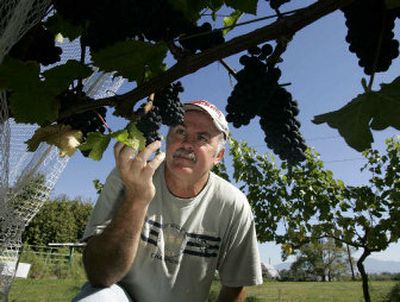Wine on the West Side

SEATTLE – People who wandered into the Olympic Cellars winery on the northern edge of the Olympic Peninsula typically had two questions for its owners.
Where are the bathrooms? And where are the grapes?
“We finally got smart and put up a sign for the restrooms,” said owner Kathy Charlton. For the second question, they commissioned a study.
Like the vast majority of the 400-plus wineries in the state, Olympic Cellars had always obtained its grapes from vineyards in hot, dry Eastern Washington, which has gained a reputation as some of the nation’s best wine country.
The study is one of two aimed at refuting the notion that good wine grapes – in particular, red wine grapes – can’t be grown on the wet side of the Cascade Range, and also finding a valuable crop to preserve farmland under increasing development pressure.
“Western Washington is the great untapped vineyard resource,” said Keith Love, a spokesman for the state’s most prominent winery, Chateau Ste. Michelle. “The potential is there, but there hasn’t been enough research done. We are glad somebody’s able to do it.”
At Charlton’s request, Southern Oregon University professor Greg Jones is studying the climate and soils of the Olympic Peninsula, hoping to identify the best spots to grow grapes.
Meanwhile in Mount Vernon, 60 miles north of Seattle, researchers from Washington State University are searching for grapes that can be grown throughout Western Washington’s many microclimates, with promising results.
The broad, flat valley near the mouth of the Skagit River is one of the coolest spots around Puget Sound, so if grapes can grow well there, they should be able to grow well in other parts, such as the warmer, south-facing slopes of the Cascade foothills.
“The interest is just getting going,” said Gary Moulton, the lead WSU researcher. “As people start moving from hobby winemaking to cottage industry, you’re going to see a lot of boutique-type wineries.”
The Puget Sound region is cooler and gets about 48 inches of rain a year – far more than Eastern Washington. For decades, that led to a perception that it was hardly worth growing wine grapes there. Even the grapes at Chateau Ste. Michelle’s suburban Seattle winery were planted only for decoration.
To the contrary, Moulton said Puget Sound compares favorably to some of the best growing regions in France and Germany. WSU’s research has shown a lot of potential for cool-weather grapes, including sauvignon blanc and pinot noir precose, as well as lesser known varieties such as the red agria.
Much of Oregon’s best wine country is on the west side of the Cascades, and though it’s a bit warmer than Western Washington – especially in the Willamette Valley – the climate isn’t that different, Moulton said.
A handful of Western Washington vineyards have grown white wine grapes – semillon and siegerebbe, among others – for years, but more have recently started planting reds based on the research. Up the Skagit River from Moulton’s 1.5-acre test plot, the Glacier Peak Winery has planted agria on his recommendation.
Just across the road, Drew Zimmerman, Carl Engebreth and Ector DeLeon have planted several varieties, but mostly pinot noir, at the 73-acre farm where they also make hard cider.
“Ultimately, we want to be a Puget Sound winery,” Zimmerman said. “We want to be among the pioneers of West Side grape growing.”